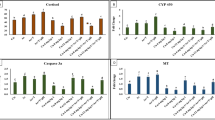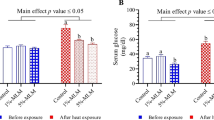Abstract
Heat stress is one of the major environmental concerns in global warming regime and rising temperature has resulted in mass mortalities of animals including fishes. Therefore, strategies for high temperature stress tolerance and ameliorating the effects of heat stress are being looked for. In an earlier study, we reported that Nrf-2 (nuclear factor E2-related factor 2) mediated upregulation of antioxidative enzymes and heat shock proteins (Hsps) provide survivability to fish under heat stress. In this study, we have evaluated the ameliorative potential of dietary curcumin, a potential Nrf-2 inducer in heat stressed cyprinid Puntius sophore. Fishes were fed with diet supplemented with 0.5, 1.0, and 1.5% curcumin at the rate 2% of body weight daily in three separate groups (n = 40 in each group) for 60 days. Fishes fed with basal diet (without curcumin) served as the control (n = 40). Critical thermal maxima (CTmax) was determined for all the groups (n = 10, in duplicates) after the feeding trial. Significant increase in the CTmax was observed in the group fed with 1.5% curcumin- supplemented fishes whereas it remained similar in groups fed with 0.5%, and 1% curcumin-supplemented diet, as compared to control. To understand the molecular mechanism of elevated thermotolerance in the 1.5% curcumin supplemented group, fishes were given a sub-lethal heat shock treatment (36 °C) for 6 h and expression analysis of nrf-2, keap-1, sod, catalase, gpx, and hsp27, hsp60, hsp70, hsp90, and hsp110 was carried out using RT-PCR. In the gill, expression of nrf-2, sod, catalase, gpx, and hsp60, hsp70, hsp90, and hsp110 was found to be elevated in the 1.5% curcumin-fed heat-shocked group compared to control and the basal diet-fed, heat-shocked fishes. Similarly, in the liver, upregulation in expression of nrf-2, sod, catalase, and hsp70 and hsp110 was observed in 1.5% curcumin supplemented and heat shocked group. Thus, this study showed that supplementation of curcumin augments tolerance to high temperature stress in P. sophore that could be attributed to nrf-2-induced upregulation of antioxidative enzymes sod, catalase, gpx, and the hsps.





Similar content being viewed by others
References
Banerjee S, Mitra T, Purohit GK, Mohanty S, Mohanty BP (2015) Immunomodulatory effect of arsenic on cytokine and hsp gene expression in Labeo rohita fingerlings. Fish Shellfish Immunol 44:43–49
Barnes JA, Dix DJ, Collins BW, Luft C, Allen JW (2001) Expression of inducible Hsp70 enhances the proliferation of MCF-7 breast cancer cells and protects against the cytotoxic effects of hyperthermia. Cell Stress Chaperone 6(4):316–325
Buckley BA, Place SP, Hofmann GE (2004) Regulation of heat shock genes in isolated hepatocytes from an Antarctic fish, Trematomus bernacchii. J Exp Biol 207:3649–3656
Chen B, Zhang Y, Wang Y, Rao J, Jiang X, Xu Z (2014) Curcumin inhibits proliferation of breast cancer cells through Nrf2-mediated down-regulation of Fen1 expression. J Steroid Biochem Mol Biol 143:11–18
DuBeau SF, Pan F, Tremblay GC, Bradley TM (1998) Thermal shock of salmon in vivo induces the heat shock protein hsp70 and confers protection against osmotic shock. Aquaculture 168:311–323
Dunsmore KE, Chen PG, Wong HR (2001) Curcumin, a medicinal herbal compound capable of inducing the heat shock response. Crit Care Med 29(11):2199–2204
Feder ME, Hofmann GE (1999) Heat-shock proteins, molecular chaperones, and the stress response: evolutionary and ecological physiology. Ann Rev Physiol 61:243–282
González-Reyes S, Guzmán-Beltrán S, Medina-Campos ON, Pedraza-Chaverri J (2013) Curcumin pretreatment induces Nrf2 and an antioxidant response and prevents hemin-induced toxicity in primary cultures of cerebellar granule neurons of rats. Oxidative Med Cell Longev 2013:1–14
Gupta SK, Pal AK, Sahu NP, Dalvi RS, Akhtar MS, Jha AK, Baruah K (2010) Dietary microbial levan enhances tolerance of Labeo rohita (Hamilton) juveniles to thermal stress. Aquaculture 306:398–402
IPCC (2007) Fourth assessment report—climate change 2007: synthesis report. IPCC, Geneva
Iwama GK, Afonso LOB, Todgham A, Ackerman P, Kazumi Nakano K (2004) Are hsps suitable for indicating stressed states in fish? J Exp Biol 207:15–19
Jain A, Samykutty A, Jackson C, Browning D, Bollag WB, Thangaraju M, Takahashi S, Singh SR (2015) Curcumin inhibits PhIP induced cytotoxicity in breast epithelial cells through multiple molecular targets. Cancer Lett 365(1):122–131
Jiang J, Shi D, Xiao-Qiu Z, Yin L, Feng L, Liu Y, Wei-Dan J, Zhao Y (2015) Effects of glutamate on growth, antioxidant capacity, and antioxidant-related signaling molecule expression in primary cultures of fish enterocytes. Fish Physiol Biochem 41:1143–1153
Jung KA, Kwak MK (2010) The Nrf2 system as a potential target for the development of indirect antioxidants. Molecules 15:7266–7291
Kato K, Ito H, Kamei K, Iwamoto I (1998) Stimulation of the stress induced expression of stress proteins by curcumin in cultured cells and in rat tissues in vivo. Cell Stress Chaperone 3(3):152–160
Khan S, Heikkila JJ (2011) Curcumin-induced inhibition of proteasomal activity, enhanced HSP accumulation and the acquisition of thermotolerance in Xenopus laevis A6 cells. Comp Physiol Biochem A Mol Integr Physiol 158(4):566–576
Kibria G (2014) Global fish kills-causes and consequences. doi: 10.13140/RG.2.1.1422.8965
Kou MC, Chiou SY, Weng CY, Wang L, Ho CT, Wu MJ (2013) Curcuminoids distinctly exhibit antioxidant activities and regulate expression of scavenger receptors and heme oxygenase-1. Mol Nutr Food Res 57:1598–1610
Madeira D, Narciso L, Cabral HN, Vinagre C, Diniz MS (2013) Influence of temperature in thermal and oxidative stress responses in estuarine fish. Comp Biochem Physiol A Mol Integr Physiol 166(2):237–243
Mahanty A, Ganguly S, Verma A, Sahoo S, Paria P, Mitra P, Singh BK, Sharma AP, Mohanty BP (2014) Nutrient profile of small indigenous fish Puntius sophore: proximate composition, amino acid, fatty acid and micronutrient profiles. Natl Acad Sci Lett 37(1):39–44
Mahanty A, Purohit GK, Banerjee S, Karunakaran D, Mohanty S, Mohanty BP (2016a) Proteomic changes in liver of Channa striatus in response to high temperature stress. Electrophoresis 37(12):1704–1717
Mahanty A, Purohit GK, Yadav RP, Mohanty S, Mohanty BP (2016b) hsp90 and hsp47 appear to play an important role in minnow Puntius sophore for surviving in the hot spring runoff aquatic ecosystem. Fish Physiol Biochem. doi:10.1007/s10695-016-0270-y
Meadus WJ (2003) A semi-quantitative RT-PCR method to measure the in vivo effect of dietary conjugated linoleic acid on porcine muscle PPAR gene expression. Biol Proced Online 5(1):20–28
Meyer A, Biermann CH, Orti G (1993) The phylogenetic position of the zebrafish (Danio rerio), a model system in developmental biology: an invitation to the comparative method. Proc Biol Sci 252(1335):231–236
Mohanty S, Mohanty BP (2009) Global climate change: a cause of concern. Natl Acad Sci Lett 32(5&6):149–156
Mohanty BP, Mohanty S, Sahoo JK, Sharma AP (2010) Climate change: impacts on fisheries and aquaculture, climate change and variability, Simard, S. (Ed.), ISBN: 978–953–307-144-2, InTech, DOI: 10.5772/9805
Mohindra V, Tripathi RK, Singh A, Singh RK, Lal KK (2014) Identification of candidate reference genes for quantitative expression analysis by real-time PCR for hypoxic stress in Indian catfish, Clarias batrachus (Linnaeus, 1758). Int Aquat Res 6:1–12
Nakano T, Kameda M, Shoji Y, Hayashi S, Yamaguchi T, Sato M (2014) Effect of severe environmental thermal stress on redox state in salmon. Redox Biol 2:772–776
Neuheimer AB, Thresher RE, Lyle JM, Semmens JM (2011) Tolerance limit for fish growth exceeded by warming waters. Nat Climate Change 1:110–113
Pirkkala L, Nykanen P, Sistonen L (2001) Roles of the heat shock transcription factors in regulation of the heat shock response and beyond. FASEB J 15:1118–1131
Purohit GK, Mahanty A, Suar M, Sharma AP, Mohanty BP, Mohanty S (2014) Investigating hsp gene expression in liver of channa striatus under heat stress for understanding the upper thermal acclimation. Biomed Res Int 2014:1–10
Purohit GK, Mahanty A, Mohanty BP, Mohanty S (2016) Evaluation of housekeeping genes as references for quantitative real-time PCR analysis of gene expression in the murrel Channa striatus under high-temperature stress. Fish Physiol Biochem 42(1):125–135
Sahin K, Orhan C, Tuzcu Z, Tuzcu M, Sahin N (2012) Curcumin ameloriates heat stress via inhibition of oxidative stress and modulation of Nrf2/HO-1 pathway in quail. Food Chem Toxicol 50(11):4035–4041
Sarkar R, Mukherjee A, Mukherjee S, Biswas R, Biswas J, Roy M (2014) Curcumin augments the efficacy of antitumor drugs used in leukemia by modulation of heat shock proteins via HDAC6. J Environ Pathol Toxicol Oncol 33(3):247–263
Teiten MH, Reuter S, Schmucker S, Dicato M, Diederich M (2009) Induction of heat shock response by curcumin in human leukemia cells. Cancer Lett 279(2):145–154
Tikoo K, Meena RL, Kabra DG, Gaikwad AB (2008) Change in post-translational modifications ofhistone H3, heat-shock protein-27 and MAP kinase p38 expression by curcumin in streptozotoc ininduced type I diabetic nephropathy. Br J Pharmacol 153:1225–1231
Tomanek L, Somero GN (2002) Interspecific- and acclimationinduced variation in levels of heat-shock proteins 70 (hsp70) and 90 (hsp90) and heat-shock transcription factor-1 (HSF1) in congeneric marine snails (genus Tegula):implications for regulation of hsp gene expression. J Exp Biol 205(5):677–685
Wahab MA, Alim MA, Milstein A (2003) Effects of adding the small fish punti (Puntius sophore Hamilton) and/or mola (Amblypharyngodon mola Hamilton) to a polyculture of large carp. Aquac Res 34(2):149–163
Wang F, Dai AY, Tao K, Xiao Q, Huang ZL, Gao M, Li H, Wang X, Cao WX, Feng WL (2015) Heat shock protein-70 neutralizes apoptosis inducing factor in Bcr/Abl expressing cells. Cell Signal 27(10):1949–1955
Washburn BS, Moreland JJ, Slaughter AM, Werner I, Hinton DE, Sanders BM (2002) Effects of handling on heat shock protein expression in rainbow trout (Oncorhynchus mykiss). Environ Toxicol Chem 21:557–560
Williams TD, Gensberg K, Minchin SD, Chipman JK (2003) A DNA expression array to detect toxic stress response in European flounder (Platichthys flesus). Aquat Toxicol 65:141–157
Yang C, Zhang X, Fan H, Liu Y (2009) Curcumin upregulates transcription factor Nrf2, HO-1 expression and protects rat brains against focal ischemia. Brain Res 1282:133–141
Zhang JF, Hu ZP, Lu CH, Yang MX, Zhang LL, Wang T (2015) Dietary curcumin supplementation protects against heat stress impared growth performance of broilers possibly through a mitochondrial pathway. J Anim Sci 93:1656–1665
Zheng Q, Wen X, Han C, Li H, Xie X (2012) Effect of replacing soybean meal with cottonseed meal on growth, hematology, antioxidant enzymes activity and expression for juvenile grass carp, Ctenopharyngodon idellus. Fish Physiol Biochem 38:1059–1069
Zhu H, Itoh K, Yamamoto M, Zweier JL, Li Y (2005) Role of Nrf2 signaling in regulation of antioxidants and phase 2 enzymes in cardiac fibroblasts: protection against reactive oxygen and nitrogen species-induced cell injury. FEBS Lett 579(14):3029–3036
Zunino B, Rubio-Patino C, Villa E, Meynet O, Proics E, Cornille A, Pommier S, Mondragón L, Chiche J, Bereder J-M, Carles M, Ricci J-E (2016) Hyperthermic intraperitoneal chemotherapy leads to an anticancer immune response via exposure of cell surface heat shock protein 90. Oncogene 35:261–268
Acknowledgements
This research was funded by the Indian Council of Agricultural Research under the National Fund for Basic, Strategic and Frontier Application Research in Agriculture (NFBSFARA; recently renamed National Agricultural Science Fund, NASF) Project No. AS-2001 (B.P.M. and S.M). A.M. is thankful to NFBSFARA for the Senior Research Fellowship. The authors are thankful to Director, ICAR - Central Inland Fisheries Research Institute, Barrackpore, and Director, School of Biotechnology, KIIT University, Bhubaneswar, for the facilities and encouragement. The authors are thankful to Dr. M. A. Hasan and Mr. Subhadeep Das Gupta (Principal Scientist and Technical Assistant respectively), ICAR-CIFRI, for helping in feed preparation. Technical assistance provided by Mr. Laddu Ram Mahaver and Mr. S. K. Pal is acknowledged. The authors would like to acknowledge the anonymous reviewers for critically reviewing the manuscript; the constructive suggestions from the reviewers have resulted in substantial improvement of the manuscript.
Author information
Authors and Affiliations
Corresponding author
Rights and permissions
About this article
Cite this article
Mahanty, A., Mohanty, S. & Mohanty, B.P. Dietary supplementation of curcumin augments heat stress tolerance through upregulation of nrf-2-mediated antioxidative enzymes and hsps in Puntius sophore . Fish Physiol Biochem 43, 1131–1141 (2017). https://doi.org/10.1007/s10695-017-0358-z
Received:
Accepted:
Published:
Issue Date:
DOI: https://doi.org/10.1007/s10695-017-0358-z




